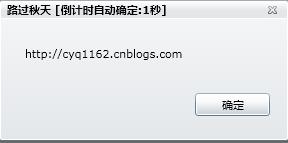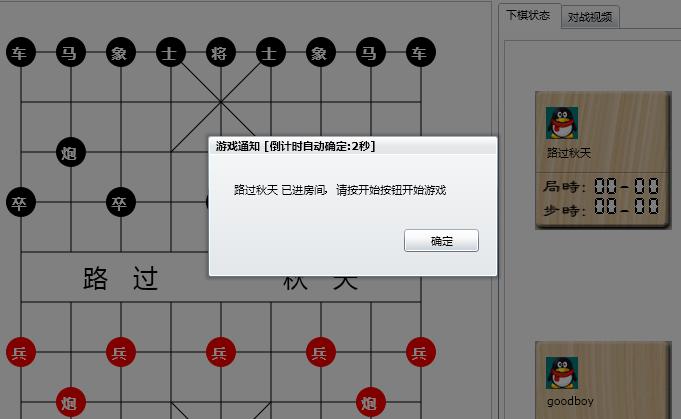Silverlight+WCF 实战-网络象棋最终篇之非线程阻塞倒计时窗口(四)
2016-11-23 12:09
453 查看
前言:
在前面的系列中,我们虽然完成了其大部分功能,但是,离正真运行,还是有一大段距离
当你F5运行时,在弹出对话框之后,如果你不即时点确定,或者上个WC回来之后,你会发现已经提示出错了
这节开始,我们将对其进行一小步一小步的优化,来避免一些明显容易引发的错误。
感知一下最原始的消息弹出框如下图:

一:传统消息框,容易引发命案
1:原始的消息框,是线程阻塞类型的,很容易引发超时问题
线程阻塞?怎么理解?
简单的说就是,WCF服务端给客户端发送了消息提示之后,一直进入等待状态,直到玩家点了确定,这时才继续做其它事情。
会产生什么问题?
玩家上WC去了?消息没人确认,自然就会超时引发异常了,而且那线程也没法接下去干其它活。
解决方案?
a:传统解决方案[加上倒计时,还是线程阻塞类型]
当初我只是想在这传统的消息框上加上倒计时自动确认,这样可以少一点避免超时情况。
于是搜了一些资料,发现要用winapi来处理,这个这个....大才小用了吧。
b:更优的解决方案
无意中发现Silverlight的ChildWindow,正好解决了这一问题。
因为 ChildWindow使用异步方式,非线程阻塞,消息一弹之后线程就回家去了。
而且用Sivlerlight内置的定时器DispatcherTimer,非常容易实现倒计时。
二:实现自定义非线程阻塞倒计时对话框,纯种Sivlerlight
1:看看纯种的长成什么样
新建项目-》Silverlight 子窗口 -》起名叫MsgBox-》找另一个界面调用一下。
比如在登陆页面测试一下:MsgBox box=new MsgBox();box.Show();
结果所见如图:

说明:
1:有背景灰色层,界面原生的还传统消息框好看多了。
2:重点提示:当初刚试的时候是直接运行MsgBox,然后在其构造函数中调用Show(),结果是出不来的。
2:改造-界面小小改动
我们将原来的xaml改造成如下:


<controls:ChildWindow x:Class="ChessProject.MsgBox" ...省略一点... Width="290" Height="141" Title="系统消息">
<Grid x:Name="LayoutRoot" Margin="2" Height="97" Width="270">
<Button Visibility="Collapsed" x:Name="CancelButton" Content="取消" Click="CancelButton_Click" Width="75" Height="23" HorizontalAlignment="Right" Margin="0,62,93,12" />
<Button x:Name="OKButton" Content="确定" Click="OKButton_Click" Width="75" Height="23" HorizontalAlignment="Right" Margin="0,62,10,12" />
<TextBlock Height="41" TextWrapping="Wrap" HorizontalAlignment="Left" Margin="15,15,0,0" Name="tbMsg" Text="请按确定按钮确定" VerticalAlignment="Top" Width="224" />
</Grid>
</controls:ChildWindow>
界面效果如图,和上图差不多[这里把取消放在前面,只是为了不显示取消时,确定还保留在原位好看点]:

3:改造,在标题加入倒计时
a:加入计时器并初始化


DispatcherTimer timer;//定时器
public MsgBox()
{
InitializeComponent();
timer = new DispatcherTimer();
timer.Interval = TimeSpan.FromSeconds(1);
timer.Tick += new EventHandler(timer_Tick);
}
b:新加show方法并实现倒计时


int defaultTime = 3;//默认N秒
string userTitle;
DispatcherTimer timer;//定时器
public MsgBox()
{
//...省略...
}
void timer_Tick(object sender, EventArgs e)
{
Title = string.Format(userTitle + " [倒计时自动确定:{0}秒]", defaultTime);
defaultTime--;
if (defaultTime == 0)
{
ResetTimer();
}
}
void ResetTimer()
{
timer.Stop();
defaultTime = 3;
}
public void Show(string msg, string title)
{
tbMsg.Text = msg;
userTitle = title;
Show();
timer.Start();
}
c:再调用一下看结果
MsgBox box = new MsgBox();
box.Show("http://cyq1162.cnblogs.com","路过秋天");
如图:

4:扩展show函数:加入回调/倒计时时间/按钮类型/默认确认类型
首先:这个子窗口是异步的,所以,在点击完确定时,需要增加多一个回调函数;
接着:默认3秒,很明显情况不同,时间也要稍为增加变动一下;
然后:有时候按钮只是确定,有时候就是取消+确定;
最后:倒计时时间到了,默认执行确定,还是执行取消。
于是,要实现了:
a:如何实现回调?
默认子窗口就有Closed事件,我们用它的事件,在点击确定或取消时,执行Close()方法


public MsgBox()
{
InitializeComponent();
timer = new DispatcherTimer();
timer.Interval = TimeSpan.FromSeconds(1);
timer.Tick += new EventHandler(timer_Tick);
this.Closed += new EventHandler(MsgBox_Closed);
}
void MsgBox_Closed(object sender, EventArgs e)
{
//待实现
}
private void OKButton_Click(object sender, RoutedEventArgs e)
{
this.DialogResult = true;
Close();//调用一下关闭
}
private void CancelButton_Click(object sender, RoutedEventArgs e)
{
this.DialogResult = false;
Close();//调用一下关闭
}
问题?我们难道对所有的确定都执行相同的代码?
首先说:异步不能像同步那样写if(show(xxx,xxx)){方法}
于是说:这是个很严重的问题,因为不同的确定,我们执行的事件肯定是不同的。
解决问题?匿名委托出手了!!!
匿名委托:[Action<T1,T2,T3...N个重载>],这是个很好用的东东,可以传进方法名称,在执行后调用不同的方法。
匿名委托实现:
Action<bool> callBackEvent;//全局定义
void MsgBox_Closed(object sender, EventArgs e)
{
if (callBackEvent != null)
{
callBackEvent(DialogResult.Value);
}
}
那委托是如何传入的?Show方法增加扩展参数传入。
b:这里贴出完整代码,一并实现:倒计时时间/按钮类型/默认确认类型


完整的MsgBox代码
public partial class MsgBox : ChildWindow
{
int defaultTime = 3;//默认N秒
string userTitle;
DispatcherTimer timer;//定时器
Action<bool> callBackEvent;
bool autoOKConfirm = true;
public MsgBox()
{
InitializeComponent();
timer = new DispatcherTimer();
timer.Interval = TimeSpan.FromSeconds(1);
timer.Tick += new EventHandler(timer_Tick);
this.Closed += new EventHandler(MsgBox_Closed);
}
void MsgBox_Closed(object sender, EventArgs e)
{
//待实现
}
void timer_Tick(object sender, EventArgs e)
{
Title = string.Format(userTitle + " [倒计时自动确定:{0}秒]", defaultTime);
defaultTime--;
if (defaultTime == 0)
{
ResetTimer();
if (autoOKConfirm)
{
OKButton_Click(null, null);
}
else
{
CancelButton_Click(null, null);
}
}
}
void ResetTimer()
{
timer.Stop();
defaultTime = 3;
}
public void Show(string msg, string title)
{
Show(msg, title, defaultTime, null, true, MessageBoxButton.OK);
}
public void Show(string msg, string title, int timeSecond, Action<bool> callBack)
{
Show(msg, title, timeSecond, callBack, false, MessageBoxButton.OKCancel);
}
public void Show(string msg, string title, int timeSecond, Action<bool> callBack, bool autoOK, MessageBoxButton button)
{
tbMsg.Text = msg;
userTitle = title;
if (button == MessageBoxButton.OK)
{
OKButton.Content = "确定";
CancelButton.Visibility = System.Windows.Visibility.Collapsed;
}
else
{
CancelButton.Visibility = System.Windows.Visibility.Visible;
OKButton.Content = "同意";
CancelButton.Content = "拒绝";
}
defaultTime = timeSecond;
autoOKConfirm = autoOK;
callBackEvent = callBack;
Show();
timer.Start();
}
private void OKButton_Click(object sender, RoutedEventArgs e)
{
this.DialogResult = true;
}
private void CancelButton_Click(object sender, RoutedEventArgs e)
{
this.DialogResult = false;
}
}
三:接下来便是苦力活了,把原来用到传统对框的提示,通通改过来。
这个改的点有点多,留到下节MsgBox使用时细细说了。
最后上一实际应用中的图:

在前面的系列中,我们虽然完成了其大部分功能,但是,离正真运行,还是有一大段距离
当你F5运行时,在弹出对话框之后,如果你不即时点确定,或者上个WC回来之后,你会发现已经提示出错了
这节开始,我们将对其进行一小步一小步的优化,来避免一些明显容易引发的错误。
感知一下最原始的消息弹出框如下图:

一:传统消息框,容易引发命案
1:原始的消息框,是线程阻塞类型的,很容易引发超时问题
线程阻塞?怎么理解?
简单的说就是,WCF服务端给客户端发送了消息提示之后,一直进入等待状态,直到玩家点了确定,这时才继续做其它事情。
会产生什么问题?
玩家上WC去了?消息没人确认,自然就会超时引发异常了,而且那线程也没法接下去干其它活。
解决方案?
a:传统解决方案[加上倒计时,还是线程阻塞类型]
当初我只是想在这传统的消息框上加上倒计时自动确认,这样可以少一点避免超时情况。
于是搜了一些资料,发现要用winapi来处理,这个这个....大才小用了吧。
b:更优的解决方案
无意中发现Silverlight的ChildWindow,正好解决了这一问题。
因为 ChildWindow使用异步方式,非线程阻塞,消息一弹之后线程就回家去了。
而且用Sivlerlight内置的定时器DispatcherTimer,非常容易实现倒计时。
二:实现自定义非线程阻塞倒计时对话框,纯种Sivlerlight
1:看看纯种的长成什么样
新建项目-》Silverlight 子窗口 -》起名叫MsgBox-》找另一个界面调用一下。
比如在登陆页面测试一下:MsgBox box=new MsgBox();box.Show();
结果所见如图:

说明:
1:有背景灰色层,界面原生的还传统消息框好看多了。
2:重点提示:当初刚试的时候是直接运行MsgBox,然后在其构造函数中调用Show(),结果是出不来的。
2:改造-界面小小改动
我们将原来的xaml改造成如下:


<controls:ChildWindow x:Class="ChessProject.MsgBox" ...省略一点... Width="290" Height="141" Title="系统消息">
<Grid x:Name="LayoutRoot" Margin="2" Height="97" Width="270">
<Button Visibility="Collapsed" x:Name="CancelButton" Content="取消" Click="CancelButton_Click" Width="75" Height="23" HorizontalAlignment="Right" Margin="0,62,93,12" />
<Button x:Name="OKButton" Content="确定" Click="OKButton_Click" Width="75" Height="23" HorizontalAlignment="Right" Margin="0,62,10,12" />
<TextBlock Height="41" TextWrapping="Wrap" HorizontalAlignment="Left" Margin="15,15,0,0" Name="tbMsg" Text="请按确定按钮确定" VerticalAlignment="Top" Width="224" />
</Grid>
</controls:ChildWindow>
界面效果如图,和上图差不多[这里把取消放在前面,只是为了不显示取消时,确定还保留在原位好看点]:

3:改造,在标题加入倒计时
a:加入计时器并初始化


DispatcherTimer timer;//定时器
public MsgBox()
{
InitializeComponent();
timer = new DispatcherTimer();
timer.Interval = TimeSpan.FromSeconds(1);
timer.Tick += new EventHandler(timer_Tick);
}
b:新加show方法并实现倒计时


int defaultTime = 3;//默认N秒
string userTitle;
DispatcherTimer timer;//定时器
public MsgBox()
{
//...省略...
}
void timer_Tick(object sender, EventArgs e)
{
Title = string.Format(userTitle + " [倒计时自动确定:{0}秒]", defaultTime);
defaultTime--;
if (defaultTime == 0)
{
ResetTimer();
}
}
void ResetTimer()
{
timer.Stop();
defaultTime = 3;
}
public void Show(string msg, string title)
{
tbMsg.Text = msg;
userTitle = title;
Show();
timer.Start();
}
c:再调用一下看结果
MsgBox box = new MsgBox();
box.Show("http://cyq1162.cnblogs.com","路过秋天");
如图:

4:扩展show函数:加入回调/倒计时时间/按钮类型/默认确认类型
首先:这个子窗口是异步的,所以,在点击完确定时,需要增加多一个回调函数;
接着:默认3秒,很明显情况不同,时间也要稍为增加变动一下;
然后:有时候按钮只是确定,有时候就是取消+确定;
最后:倒计时时间到了,默认执行确定,还是执行取消。
于是,要实现了:
a:如何实现回调?
默认子窗口就有Closed事件,我们用它的事件,在点击确定或取消时,执行Close()方法


public MsgBox()
{
InitializeComponent();
timer = new DispatcherTimer();
timer.Interval = TimeSpan.FromSeconds(1);
timer.Tick += new EventHandler(timer_Tick);
this.Closed += new EventHandler(MsgBox_Closed);
}
void MsgBox_Closed(object sender, EventArgs e)
{
//待实现
}
private void OKButton_Click(object sender, RoutedEventArgs e)
{
this.DialogResult = true;
Close();//调用一下关闭
}
private void CancelButton_Click(object sender, RoutedEventArgs e)
{
this.DialogResult = false;
Close();//调用一下关闭
}
问题?我们难道对所有的确定都执行相同的代码?
首先说:异步不能像同步那样写if(show(xxx,xxx)){方法}
于是说:这是个很严重的问题,因为不同的确定,我们执行的事件肯定是不同的。
解决问题?匿名委托出手了!!!
匿名委托:[Action<T1,T2,T3...N个重载>],这是个很好用的东东,可以传进方法名称,在执行后调用不同的方法。
匿名委托实现:
Action<bool> callBackEvent;//全局定义
void MsgBox_Closed(object sender, EventArgs e)
{
if (callBackEvent != null)
{
callBackEvent(DialogResult.Value);
}
}
那委托是如何传入的?Show方法增加扩展参数传入。
b:这里贴出完整代码,一并实现:倒计时时间/按钮类型/默认确认类型


完整的MsgBox代码
public partial class MsgBox : ChildWindow
{
int defaultTime = 3;//默认N秒
string userTitle;
DispatcherTimer timer;//定时器
Action<bool> callBackEvent;
bool autoOKConfirm = true;
public MsgBox()
{
InitializeComponent();
timer = new DispatcherTimer();
timer.Interval = TimeSpan.FromSeconds(1);
timer.Tick += new EventHandler(timer_Tick);
this.Closed += new EventHandler(MsgBox_Closed);
}
void MsgBox_Closed(object sender, EventArgs e)
{
//待实现
}
void timer_Tick(object sender, EventArgs e)
{
Title = string.Format(userTitle + " [倒计时自动确定:{0}秒]", defaultTime);
defaultTime--;
if (defaultTime == 0)
{
ResetTimer();
if (autoOKConfirm)
{
OKButton_Click(null, null);
}
else
{
CancelButton_Click(null, null);
}
}
}
void ResetTimer()
{
timer.Stop();
defaultTime = 3;
}
public void Show(string msg, string title)
{
Show(msg, title, defaultTime, null, true, MessageBoxButton.OK);
}
public void Show(string msg, string title, int timeSecond, Action<bool> callBack)
{
Show(msg, title, timeSecond, callBack, false, MessageBoxButton.OKCancel);
}
public void Show(string msg, string title, int timeSecond, Action<bool> callBack, bool autoOK, MessageBoxButton button)
{
tbMsg.Text = msg;
userTitle = title;
if (button == MessageBoxButton.OK)
{
OKButton.Content = "确定";
CancelButton.Visibility = System.Windows.Visibility.Collapsed;
}
else
{
CancelButton.Visibility = System.Windows.Visibility.Visible;
OKButton.Content = "同意";
CancelButton.Content = "拒绝";
}
defaultTime = timeSecond;
autoOKConfirm = autoOK;
callBackEvent = callBack;
Show();
timer.Start();
}
private void OKButton_Click(object sender, RoutedEventArgs e)
{
this.DialogResult = true;
}
private void CancelButton_Click(object sender, RoutedEventArgs e)
{
this.DialogResult = false;
}
}
三:接下来便是苦力活了,把原来用到传统对框的提示,通通改过来。
这个改的点有点多,留到下节MsgBox使用时细细说了。
最后上一实际应用中的图:

相关文章推荐
- Silverlight+WCF 实战-网络象棋最终篇之非线程阻塞倒计时窗口-应用篇(七)
- Silverlight+WCF 实战-网络象棋最终篇之非线程阻塞倒计时窗口(四)
- Silverlight+WCF 实战-网络象棋最终篇之非线程阻塞倒计时窗口(四)
- Silverlight+WCF 实战-网络象棋最终篇之非线程阻塞倒计时窗口-应用篇(七)
- Silverlight+WCF 实战-网络象棋最终篇之非线程阻塞倒计时窗口-应用篇(七)
- Silverlight+WCF 实战-网络象棋最终篇之非线程阻塞倒计时窗口-应用篇(七)
- Silverlight+WCF 实战-网络象棋最终篇之对战视频-下篇[客户端发送与服务端中转](六)
- Silverlight+WCF 实战-网络象棋最终篇之对战视频-上篇[客户端开启视频/注册编号/接收视频](五)
- Silverlight+WCF 实战-网络象棋最终篇之对战视频-上篇[客户端开启视频/注册编号/接收视频](五)
- Silverlight+WCF 实战-网络象棋最终篇之对战视频-上篇[客户端开启视频/注册编号/接收视频](五)
- Silverlight+WCF 实战-网络象棋最终篇之对战视频-下篇[客户端发送与服务端中转](六)
- Silverlight+WCF 实战-网络象棋最终篇之房间装修-Silverlight端[带第九阶段源码](三)
- Silverlight+WCF 实战-网络象棋最终篇之解决重复的消息提示(八)
- Silverlight+WCF 实战-网络象棋最终篇之解决重复的消息提示(八)
- Silverlight+WCF 实战-网络象棋最终篇之解决重复的消息提示-状态重置(九)
- Silverlight+WCF 实战-网络象棋最终篇之解决重复的消息提示-状态重置(九)
- Silverlight+WCF 实战-网络象棋最终篇之十字轨迹(一)
- Silverlight+WCF 实战-网络象棋最终篇之房间装修-Silverlight端[带第九阶段源码](三)
- Silverlight+WCF 实战-网络象棋最终篇之十字轨迹(一)
- Silverlight+WCF 实战-网络象棋最终篇之解决重复的消息提示(八)
